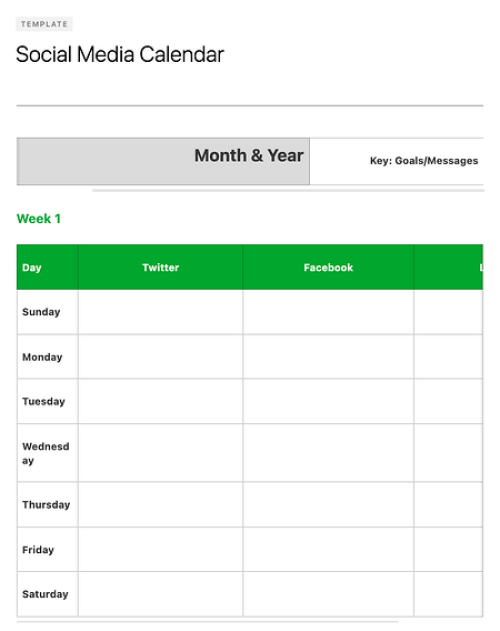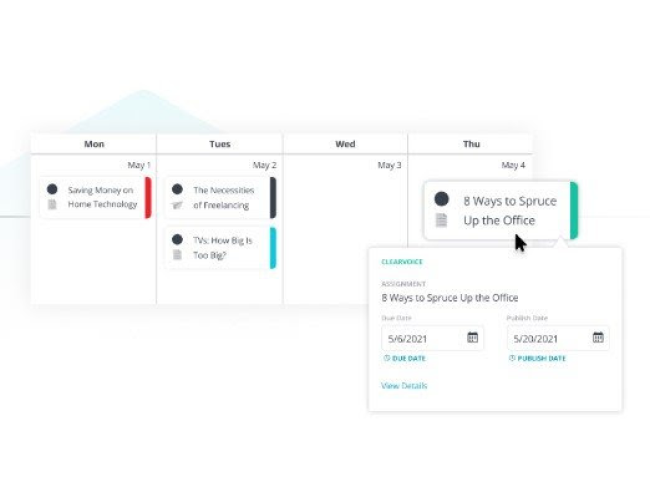What do cross-country road trips, wedding speeches, and social media marketing have in common? Planning. I can't help you with your road trip or wedding speech, but I have a solution for planning your next social media marketing campaign — using a social media calendar!
Most marketers now recognize that social media is integral to an effective inbound marketing strategy. With so many social networks available to us, it's crucial to stay organized and plan for when and what you will share on these platforms.
Table of Content
Before we dive into our list of top tools to stay organized, here's what you need to know about social media calendars and why they're essential.
What is a social media calendar?
How to Create a Social Media Calendar
Social Media Content Calendar Tools to Plan Your Messaging
The Benefits of Using a Social Media Content Calendar
Social Media Calendar Examples
How To Create a Social Media Posting Schedule for Your Business
How To Create a Content Calendar
What is the best social media calendar?
What is a social media calendar?
A social media calendar is a rundown of your upcoming posts organized by date and time. A social media calendar can be a spreadsheet, digital calendar, or interactive dashboard.
To get the most value out of your social media calendar, it may include the following:
- The date and time a post will go live
- The social media account or network will go live on
- Materials that will be included, such as copy, hashtags, links, and graphics

How to Create a Social Media Calendar
To create an effective social media calendar, you should:
1. Conduct a social media audit.
A social media audit assesses your social media presence, accounts, and engagement so you can see what's working, what's not, and where improvements need to be made. To learn how to conduct a social media audit, click here.
2. Choose your social media channels and the content you'll post.
After conducting a social media audit, you should comprehensively understand which channels your audience uses and the kind of content they prefer. You should use your findings to determine which social media channels you'll leverage and the content you'll post.
For example, you may notice your audience prefers your behind-the-scenes content on Instagram but goes to Twitter to ask questions and learn more about your product. In that case, you can post fun behind-the-scenes photos and Reels on Instagram, then use Twitter to share information about your product and answer consumer questions.
3. Decide what your calendar should include.
Your social media calendar should be tailored to your business and goals, so you'll need to include information in our calendar that will make your desired results.
To start, your calendar should include the following:
- The platforms you're using
- The day and the time your posts will be published
- Links, graphics, videos, and copy
As you become more adept with your calendar, you may want to expand it to include the following:
- Platform-specific materials include Reels, TikTok LIVE, polls, shoppable posts, etc.
- Geo-targeting
- The associated or vertical campaigns, such as product launches and contests
4. Get feedback.
Once your calendar is complete, share it with your team and stakeholders to get their feedback to ensure it meets everyone's needs. As you use the calendar, you may find ways to improve or expand upon it; you'll need to be open to ongoing feedback.
Social Media Content Calendar Tools to Plan Your Messaging
1. HubSpot's Downloadable Template for Excel
Content Calendar
Price: Free
 Download This Template
Download This Template
Marketers might already use Excel for different types of reports and data analysis, but this multifaceted tool is also perfect for social media content calendar organization. Excel can be customized according to the priorities and metrics your team is focused on, so it's a great option for planning.
The good news? We've already done the heavy lifting by creating a free, downloadable social media content calendar template using Microsoft Excel. Marketers can easily use this template to plan individual social media posts— monthly or annually — while keeping an eye on more significant picture events, holidays, publications, and partnerships.
- Use the Monthly Planning Calendar Tab above to get a bird's-eye view of what's coming down the content pipeline in a given month.
- In the Content Repository tab, you can add the content you'll be publishing on this tab to keep track of which pieces have been promoted already and to recall older content that can be re-promoted easily.
- You can draft and plan out social media posts in advance on the Social Network Update tabs. These tabs are for organizational purposes. After planning out your social media posts, you'll manually upload the content of the posts to a social media publisher.
For more on how to use the templates, check out this in-depth guide from my colleague Basha Coleman.
This free resource can draft social media posts or bulk-upload them into a publishing app to maximize efficiency. (HubSpot customers: You can use this spreadsheet to organize content and upload it directly into Social Inbox. For instructions on this, check out the template's cover sheet here.)
Why we like this social media tool:
Marketers with small teams and heavy workloads will love this intuitive template. It acts as a social media content planner, tracker, and archive, making it perfect for sharing your social plan with stakeholders and referring to it when you need to repurpose old content.
2. Google Drive
Content Calendar and Asset Organization
Price: Free for personal use. Google Workspace plans for businesses start at $6 per month.
Google Drive has several helpful features that make it easy for social media marketers to build an effective content calendar.
Here's an example of how a team might use Google Calendar to track their editorial and social media calendars to ensure posts align with new blog content. Multiple teams can easily share these calendars to avoid scheduling conflicts and align campaigns.

Marketers can also use shared Google Sheets to schedule posts on social media, track the status of different pieces of content, and assign tasks to team members without switching between platforms.

With the help of Google Docs, users can keep comments in one place and collaborate on different projects without emailing back and forth or scheduling a meeting. This is a handy feature when editing content for social media, which may need to be drafted and approved quickly.

Why we like this social media tool:
Google has several products that can be used together to create quick, seamless workflows. So you'll find value in the Google Drive system if you publish dozens of daily posts across multiple platforms or ramp up one channel for your freelance business. The best part is that HubSpot customers can easily link their Google Drive accounts to the HubSpot portal to upload files from Drive into the HubSpot software.
3. Loomly
Content Planning, Creation, Publishing, and Calendar
If you want more mileage from your content calendar, you can turn to an all-in-one content planning and publishing platform such as Loomly.
Loomly's most robust feature set includes a collaboration and approval environment so teams can submit mockups, provide comments, see version logs, and flag for approval. This can help you streamline processes for efficiency when there are "too many cooks in the kitchen" on a particular project.
Why we like this social media tool:
This tool can do both if your team is responsible for organic and paid social. And your team who wants to avoid using their personal account for social media duties can respond to comments and replies directly in Loomly — that means they won't need to log in to each native platform to engage with followers.
4. Trello
Task Management and Content Calendar
Price: Free for individual use. The Standard plan starts at $5 per user per month, billed annually.

They are looking for an organizational tool that's highly effective for team collaboration. Try Trello. This platform offers a full calendar view, making it easy to visualize what content is going out and when. More specifically, social media managers can use Trello's flexible assignment “cards” and customizable “boards” and “lists” to map out to-do lists, manage a content calendar, plan a campaign, and store brainstorming ideas.
You're not limited to just one structure, however. Users can customize boards according to their needs. For example, a team could create a board to organize social media posts for a given week on a specific platform or post ideas around a topic, such as a campaign or awareness day.
Why we like this social media tool:
Trello cards can be assigned to different team members, marked with due dates, and commented on. Users can even customize labels with varying statuses of publication so the entire team can see the progress of their social media posts and when they're due on the calendar. The labels could also indicate different social networks where content is being published.
5. SproutSocial
Social Publishing and Content Calendar
Price: The Standard plan starts at $249 monthly for five social profiles, billed annually.

Sprout Social’s social media calendar and publishing tool make it easy for teams or individuals to plan and schedule their social posts. You can schedule content to automatically post to Twitter, Facebook, Instagram, LinkedIn, Pinterest, and more.
You can also tag each social post and add notes to track and report your posting strategy and campaigns. Additionally, their publishing suite includes Optimal Send Times, which analyzes your social media data and automatically publishes when your audience is most engaged.
Why we like this social media tool:
Coming up with social media content ideas can take time and effort. Sprout Social's social listening tool lets marketers like you uncover niche conversations that your audience is interested in. From there, you can join the conversation for brand awareness or start your discussion on the topic to grow your following.
6. Evernote
Content Calendar, Task Management, and Asset Organization
Price: The Basic plan is free. Create a custom template using the Personal program for $8.99 per month.

Evernote is a note-taking app that marketers can use to keep track of all the moving parts of a social media campaign.
The tool also features yearly, monthly, weekly, and hourly logs, making it easy to track when you're publishing content on social media when you're producing blog content and other team-wide priorities. (Evernote offers customizable templates for each of these that can be downloaded into the app.)
Another helpful feature is Evernote's Web Clipper extension for Chrome. Marketers can use this tool to easily save links to their Evernote Notebook for sharing later on.
Why we like this social media tool:
The Evernote mobile app also boasts interesting features to help marketers keep their social content ideas straight. For example, you can easily snap a photo and save it to your Evernote files for review later. This feature is of particular value for social content creators looking to maintain a backlog of photos to publish on Instagram.
7. Hootsuite
Social Publishing and Content Calendar
Price: The Professional plan starts at $49 per month and begins with a free 30-day trial.

Hootsuite offers a built-in Planner tool to help you create campaigns, identify publishing gaps, and collaborate with your content creation team. Its primary features are in social publishing so that you can release content to your networks in advance, but it also has rich features for collaboration and post approvals.
You can even curate content from other sources without logging into your account. Once your content is created, you can preview it with the Composer tool, which displays it according to each social network's unique format.
Why we like this social media tool:
Cross-collaboration is a big deal on any marketing team, and Hootsuite has a way of making this even more accessible. The social publishing platform has a built-in content library serving as the single truth point for your entire organization. Does your sales team need a product feature cheat sheet? Customer service looking for details on the latest product feature? All that and more can be found in your team's Hootsuite content library.
8. Agorapulse
Social Publishing and Content Calendar
Price: The individual plan is free, or you can use the Pro plan for small teams starting at $79 per month.

Like Hootsuite, Agorapulse offers social publishing tools and a content calendar to manage your social media accounts easily. This includes scheduling (or rescheduling), queuing, and bulk uploading posts, which is incredibly helpful for teams who use quarterly or monthly content plans.
Why we like this social media tool:
What makes Agorapulse different is its social inbox, which allows you to manage all the interactions from various platforms in a single place. After all, content isn't just a one-and-done activity; it's about building awareness and engagement with your readers.
9. StoryChief
Content Planning and Distribution
Price: Team pricing starts at $100 per month, billed annually.

If you want more from your content calendar than knowing when posts go live, StoryChief is your option. With StoryChief's smart calendar, you can better strategize and plan your content strategy across channels.
It displays much more than your timetable — it also allows you to assign collaborators to tasks and filter them by the campaign. StoryChief self-describes its tool as a "content distribution platform" that unifies analytics and publishing across multiple channels for a more simplified approach to content creation. Best of all, it syncs with HubSpot and your favorite calendar apps.
Why we like this social media tool:
Believe it or not, there are quite a few similarities between social media marketing and SEO marketing— StoryChief bridges this gap with its SEO Copywriting tool. By highlighting the areas you can improve your copy for the reader (and subsequently the search engines), you can write more precise, more engaging content that works on social media and your website or blog.
10. ClearVoice
Content Creation and Management
Price: Prices for Level 1 users start at $510 per month.

So what about content planning and creation? ClearVoice offers content creation tools to fit into your workflow. Their big claim to fame is their Talent Network Search which allows you to find and connect to content creators to work on your projects. Yet, ClearVoice also has features for task management for internal and external collaborators.
You can create, edit, and approve projects in an interface that makes editorial management easy. It also includes a dashboard and dynamic editorial calendar with plenty of interactive functionality and integrations with other popular software.>
Why we like this social media tool:
Not every social team is working for a big agency or client. For freelance content teams who want to stay organized and on time with their social media publishing, ClearVoice offers some of the same great features at a price customized to your team.


